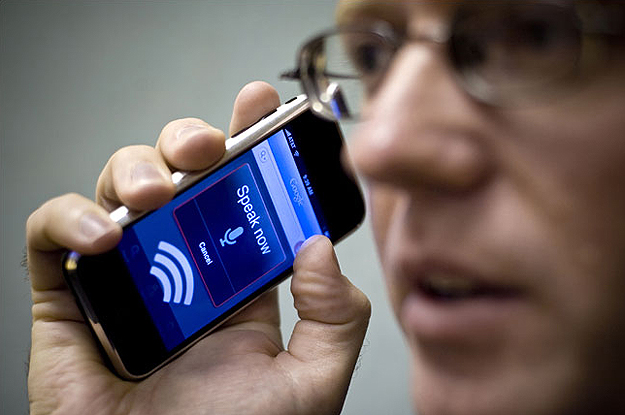
Talking to a device to accomplish tasks used to be a futuristic dream. For many, it’s now a way of life.
The Future Is Here: The Evolution of Voice Recognition Software.
Speaking into a digital device to accomplish tasks used to be a futuristic dream. For many, it’s now a way of life. It may have started with smartphones and cars, but current voice recognition software lets people do a lot more than “call Joe” or find the address for a nearby restaurant. TVs, alarm systems and even appliances can be controlled by voice commands these days, as developers are now able to connect the functionality of these applications to voice recognition software.
The ability to communicate with our devices has been a goal of researchers since as far back as 1936, when Bell Laboratory ran a trial of electronic speech synthesis, notes Digitalist Magazine contributor Geetika Shukla. In the 1950s, says an article from the MIT Technology Review, new computers could recognize as many as 10 words if spoken by one person. By the 1990s, machines could create decent transcripts based on the spoken word.
Since then, the technology has improved enormously, mostly in the last 10 years or so. Voice activation software is now beginning to simulate a real person, or an assistant, who performs tasks and finds answers when asked to do so. Users can tell devices equipped with voice-control to find a phone number, get directions, set reminders and alarms, play music, search the web, send a text message, turn on and off lights, or change TV programming – and that’s just a short list. But all of these conveniences are not the only reason voice recognition technology is becoming more of a reality.

Why voice recognition is so popular.
By allowing hands-free interaction, voice recognition allows for multi-tasking and increased productivity. Imagine someone is cooking in a home kitchen while listening to music through a speaker system. This person needs to also simultaneously create a digital grocery list based on the ingredients being used up and check the traffic report to see if his or her spouse will be coming home late. Conveniently, this can all be done with simple voice commands. If all these tasks had to be done separately by hand, it would take much longer.
In today’s culture, people are always looking for ways to be more efficient, and voice-activated commands make that easier by removing the need to type every letter out on a keyboard or search, scroll and click to find information. Mary Meeker, a well-known financial analyst, spoke at a conference in southern California recently and told attendees her prediction that 50 percent of all searches online will be done through voice and image by 2020. It’s hardly an outlandish prediction, as voice control is more natural and may allow people to be more productive.
What does the future of voice recognition software look like?
While communication with our devices seems incredible and almost futuristic, society seems to be heading in that direction. The goal is to create devices that understand and react to conversational speech by searching multiple sources for the most relevant information and providing any additional resources based on context. Although a lot of progress has and is being made, technology is still somewhat lacking in these areas. But the future of voice recognition software is bright.
As improvements in voice recognition accuracy continue, it’s probable the market will need more devices that are “always listening” or ready to interject personalized assistance any time it is needed. This may require the creation of new, even-more intelligent speech recognition software that can connect to more advanced devices, which researchers and developers are likely already building.
Data suggests the future of this industry is going to continue to see rapid growth as researchers keep finding the latest and most advanced technologies. Voice recognition software will expand further into additional products and become a natural part of life, providing information where and when people need it. The future of speech recognition is likely to include advancements in the following:
As these new solutions emerge in the voice recognition market, current systems and applications must be able to integrate if they want to keep up with today’s multitasking consumer.
Integrating voice recognition with existing technology:
Whether for commercial or in-house interfaces and workflows, there are two primary ways to add voice recognition software to an existing application. The first is mainly for developers, as it entails implementation and requires coding knowledge. Several companies, such as Google, Apple and Amazon, offer software development kits (SDKs) that include software libraries, code samples and documentation to assist in the integration of speech recognition capabilities into a platform.The second, and best, option when looking to integrate voice recognition technology with existing systems is to hire a software development company to do it for you. A professional can also build a new system with verbal capabilities if a total refresh of old software is necessary.
Although it is not likely that electronic devices will soon be equivalent to humans, advancing technologies are making devices smarter. This includes improving voice recognition and making a system’s understanding of speech more realistic and natural. As research and development continue, voice-controlled technology will likely play a bigger role in daily life and the latest and greatest devices will have to include speech recognition software to keep up with user demand.
Contact Syrinx with questions about how we can incorporate speech recognition into your business.
Resources - MobileIndustryReview.com - TechnologyReview.com - TechCrunch.com - DigitalMag.com - Recode.net - TheGuardian.com - Globalme.net
Consumers demand apps, and businesses keep supplying them, but many companies are struggling to maintain such a fast pace when it comes to mobile app development. After all, there are a lot of moving parts that must line up perfectly to develop an app in a traditional sense with all the bells and whistles – dedicated native developers, development tools, backend systems, testing environments and more. That is one of the major reasons why brands today are turning to rapid mobile app development.

With approaches that entail quickly creating high-performing and great-looking apps, businesses are able to release their apps faster, which means generating a return on those investments sooner. But rapid mobile app development isn't just a strategy. It requires a solution: a mobile app development platform that provides frameworks and APIs for creating custom apps. That tool must also, however, allow developers to code apps that support all mobile device operating systems.
Enter Xamarin. This rapid mobile development platform is invaluable in 2016. It ensures that brands can build, test and support apps throughout their entire lifecycles thanks to a coding language called C#. That code is automatically converted to native code for each mobile OS via a hosted .NET environment. With Xamarin quick cross-platform development gets simpler. Third-party app development firms take advantage of these tools, and the results are great. It's because Xamarin allows developers to create any app they want – Xamarin supports apps, such as JetBlue's, as well as mobile games such as Bastion.
Xamarin rapid mobile development platform is invaluable in 2016.
In the news
Recently, Microsoft announced that its has agreed to acquire Xamarin. This might sound surprising, but Ars Technica's Peter Bright reported that this partnership has been a long time coming. As the source explained, Xamarin was a spin-off company of Ximian , which originally created Mono – an open source version of .NET. And Microsoft released the first .NET in the 2000s as a way to develop cross-platform apps. Once Xamarin began its life as a tech firm, it started to finish Mono. Therefore, Bright asserted, technically speaking, Xamarin finished what Microsoft started years ago – it's come full circle.
Then, in the past few years, Microsoft and Xamarin partnered to integrate Microsoft's Visual Studio with the rapid mobile development platform, Bright wrote. In 2014, the relationship grew strong when Microsoft made .NET partially open source, giving Xamarin better support for .NET. So, historically, the partnership between Microsoft and Xamarin has yielded good results.
In that regard, many industry experts think that the acquisition is promising. More importantly, it reflects how important cross-platform mobile app development really has become. Microsoft understands that app development must improve across the board, and it wants to be in on the ground floor of innovation. WIRED's Klint Finley supported that thinking, clearing the air around what exactly this acquisition means for the underlying Xamarin platform and other backend services. The good news, Finely explained, is that this wasn't a case of absorbing key players from Xamarin and throwing away the rest – a process known in the industry as "acquihiring."
"This is definitely not an acquihire," Scott Guthrie, executive vice president of Microsoft's cloud and enterprise group, told the source. "There are more than 300 people on the Xamarin team. We very much view this acquisition as an opportunity to take what they've built and make it a core part of our strategy."
The impact of it all
Therein lies the question for many brands looking into Xamarin right now as a solution for mobile app development. If these companies already have a plan to leverage the platform with help from a third-party development, will anything change? No, but also yes.
For one, out of this deal, Microsoft gets some benefits, yet the acquisition isn't likely to change Xamarin or mobile app development for a while. For ZDNet, Forrester Vice President and Principal Analyst Jeffrey Hammond and Principal Analyst Michael Facemire wrote that the mobile backend as a service aspect of Xamarin could soon live on Microsoft's Azure public cloud service infrastructure.
When it comes to businesses that want to use Xamarin, the Forrester analysts asserted that this acquisition makes the mobile development platform more attractive. Now, "mainstream buyers" have no reason to be concerned about using a cloud service from a smaller provider, they argued, and since few mobile developers "are comfortable with the current status quo," they now have a great option.
Nowadays, a mobile app needs to provide it all. It must have a great user interface that provides consumers with a variety of features and capabilities while avoiding the complexities that can come with too many options. Beyond that, a mobile app has to ensure it's bug- and glitch-free, as well as perform optimally, regardless of the devices it's opened on or the other apps running in the background. It should offer something that is unique, such as a loyalty or rewards program, as that can keep users engaged and frequently interacting. And perhaps most importantly, a mobile app must seamlessly connect with existing accounts to provide a personalized experience.

That probably sounds like a lot, but in the extremely competitive app market of 2016, overlooking a single feature, capability or end-user expectation could spell disaster – a poor review or, worse, a deleted app.
To build mobile apps that truly provide it all, brands should look for full-stack developers. Those are IT employees who "understand the implications of technical decisions from core layers of software onto the presentation layer," as Hossein Rahnama, founder and chief product officer at Flybits, explained to InfoWorld. Full-stack developers can work on the backend, integrating APIs into a mobile app's code one day, and the next, they're able to turn around and improve the end-user experience. No wonder Rahnama called these individuals "great assets": In today's cross-platform mobile app market that demands native experiences, brands want full-stack developers to bring their apps to every mobile platform while maintaining high-quality.
Overlooking a single end-user expectation could spell disaster in app development.
No full-stack developers for you
Unfortunately, finding a developer or IT professional with the traits for their full-stack fluent peers proves difficult. Randstad Technologies Group President of Technology and Engineering Robert Dickey said that full-stack developers are some of the most wanted IT employees in 2016, according to CIO magazine. After all, individuals with wide skill sets in the back-end and front-end of mobile app development likely want higher salaries and important positions.
Solving the problem
The best choice for businesses that want amazing apps that provide it all is to partner with organizations that specialize in mobile app development and use tools such as Xamarin that make full-stack skills obsolete.
Why partner with a specialized firm? Sarah Williams, contributor for Newswire, explained that the stack is wider than ever, making it difficult for brands to hire a developer on their own who understands Android and iOS development as well as how to build out and support back-end infrastructure. The "full-stack" only gets more complex when factoring in additional smart devices as well as must-have features such as mobile payments and loyalty and rewards system integration.
With a platform such as Xamarin and a mobile app development partner that has developers with a lot of experience in building apps across devices, brands don't have to worry about finding and hiring full-stack skilled professionals. Those companies can provide staff with passions in a wealth of areas, ensuring that the best UI people work on UI while the backend infrastructure is handled by someone with expertise in that regard.
Consumers might want to have "it all" with respect to their mobile apps, but brands don't need to find developers who can do it all when they can rely on partners that leverage cross-platform development tools and supply professionals that excel at what they do.